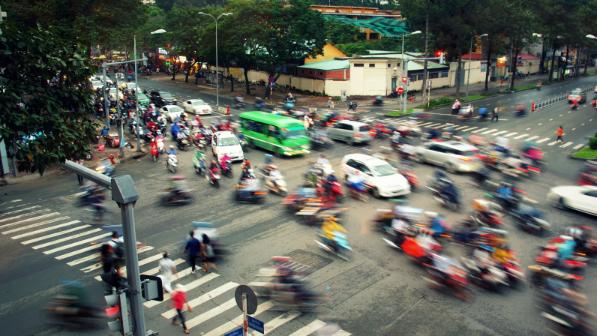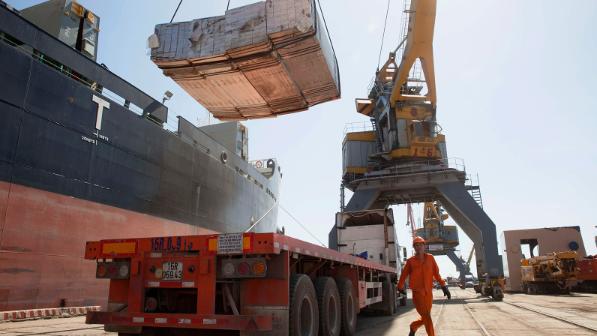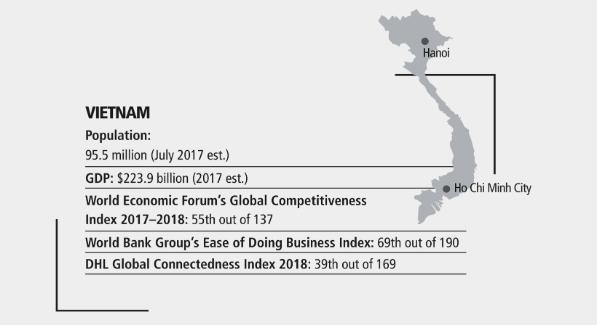After decades of war, recovery, seclusion and economic stagnation, Vietnam has arisen as one of the hottest emerging markets in Asia. On the back of a booming manufacturing sector, a favorable geographic location, heavy investments in infrastructure and key trade pacts with several big economies, Vietnam has transitioned from being one of the poorest countries in the world to a highly sought destination for the world’s largest companies. Nevertheless, there are still challenges as the country rushes to fill its infrastructure gap.
The emerging market story
The modern Vietnam story starts roughly 30 years ago when the country first began opening up to foreign -investment. At this time, the country was the quintessential backwater, with a GDP in the ballpark of $6 billion, and was scarcely on the radar of the world economy. Now, after three decades of concerted economic reform, Vietnam has jumped to the forefront of Asia’s new guard of booming economies with a GDP that topped $223 billion last year and a growth rate hovering around 7 percent. According to MIT research, Vietnam became the 21st largest exporter in the world in 2016, with an $11 billion trade surplus – a complete about-face from 1995, when the country faced a $2.29 billion deficit. By 2017, trade as a percentage of Vietnam’s GDP was in the ballpark of 200 percent, which is the highest figure the World Bank has ever measured for a country with over 50 million people.
This economic success can partly be attributed to Vietnam’s participation in a variety of major international trade organizations and agreements. In 2007, Vietnam joined the World Trade Organization (WTO), it has been a member of ASEAN since 1995, and was one of the original signatories to the Trans-Pacific Partnership. In addition to being part of the ASEAN free trade area, it has established key trade pacts with China, Australia, New Zealand, Korea, India, Japan and the Russian-led Eurasian Economic Union, and a big free trade agreement with the European Union will soon come into effect.
In addition to integrating into the global economy in terms of trade, Vietnam is liberalizing its domestic policies in regards to business ownership and investment, now allowing foreign firms to have 100 percent ownership of a company in Vietnam.
Favorable geography
Enhancing Vietnam’s ability to interconnect with the world’s biggest economies is its prime geographic location. With 3,260 kilometers of coastline facing one of the busiest shipping lanes on the planet, the country is a natural import/export hub.
“The geographic location is important,” says Shoeib Choudhury, Country Manager & General Director, DHL Express Vietnam. “It’s highly connected to China on the northern side, which makes the supply of raw materials quite easy for manufacturing, and through the North China Sea and Pacific it’s also connected to North America.”
Absorbing industry from china
Since at least 2015, Vietnam has also become the beneficiary of some of the drastic economic transitions that China is currently experiencing. Wages in China have been rising rapidly, low-paid manual laborers are becoming harder to find, and the country’s economic growth is starting to level off – not to mention the recent start of a trade war with the United States.
“If you’re exporting from China to places like America, companies are just jumping, they’re biting at the bit to get out and move to places like Vietnam,” explains Trent Davies of Dezan Shira & Associates, a pan-Asian foreign direct investment firm. “Vietnam is very lucky in terms of its close proximity to China, but also because it has got these FTAs and its labor costs are low.”
Vietnam’s minimum wage is currently 60 percent of China’s and its manufacturing sector has been consistently growing at double-digit rates, topping 12 percent in the first three quarters of 2018 – partially due to the sudden influx of companies fleeing China.
This has nearly pushed Vietnam to the limits of its capacity, putting pressure on land access, adequately skilled labor and infrastructure. “We do a lot of work with companies coming from China to Vietnam now, and they’re saying that they need warehousing or factory space in an industrial zone, and we’re actually struggling to find the space for them,” Davies says. “A lot of the industrial zones are filling up very, very quickly.”
However, this recent absorption of companies from the north doesn’t spell an all-out exodus of China’s manufacturing sector. Rather, many companies are employing what’s called the “China+1” strategy, where they will carry on their existing operations in China while moving a portion of their production to Vietnam. This allows them to take advantage of what a rapidly emerging Vietnam offers while still maintaining their presence in the world’s second largest economy.
Too much, too quickly?
Vietnam’s rapid economic ascent has put extreme pressure on the country’s infrastructure network, causing bottlenecks at ports, congestion on highways and delays at airports. On the issue of whether Vietnam’s infrastructure is developed enough, Drew Duncan, Managing Director, DHL Supply Chain Vietnam, responds, “No, it’s definitely underdeveloped.”

To alleviate these problems and ensure that its economy can continue growing, Vietnam has been investing heavily in infrastructure – to the tune of 5.7 percent of its GDP – improving railways, highways, seaports and airports across the country. A $58 billion, 1,545-kilometer high-speed rail line connecting Hanoi with Ho Chi Minh City, Vietnam’s two largest and most important metropolises, is set to begin construction. A significant and long overdue expansion of Ho Chi Minh City’s airport is also currently in the works. Meanwhile, both cities are in the process of installing new metro systems. And there are also ambitious plans to improve Vietnam’s national road network.
Ascending the value chain
Vietnam burst onto the global economic scene by establishing itself as a profitable place to manufacture low-tech consumer goods, textiles and footwear for export, but has recently evolved away from being a monofaceted factory nation. While the country continues to serve as a hub for T-shirt and sneaker production, it is also moving into more complex sectors, cultivating high-end fashion, pharmaceutical, automobile and high-tech industries.

The Vietnamese government has initiated a slate of policies to incentivize investment from foreign tech and pharmaceutical companies looking to move production and establish R&D operations in the country, including free rent, tax breaks, and infrastructural support. And the market responded. Big firms like Samsung, LG, Foxconn and Intel; automobile manufacturers such as Hyundai and Yamaha; and multinationals like Colgate, Palmolive and Pepsi all moved right in, dramatically boosting Vietnam’s position on the industrial value chain.
“In the past, it was all in the field of manufacturing, there was no R&D in Vietnam,” DHL’s Choudhury explains. “Today, many of the big companies are setting up R&D departments here.”
The trickle-down impact of bringing in large multi-national tech firms has resulted in vibrant startup scenes around Ho Chi Minh City and Hanoi. The Vietnamese government has encouraged this type of entrepreneurship with several programs devoted to startups, including a big innovation hub in Ho Chi Minh City for fledgling tech companies. According to Davies, this has paid off, and the number of co-working spaces in Hanoi alone has quadrupled in the past couple of years.

“There are a lot of household businesses in Vietnam but people are always looking for new ways to do things better,” Davies explains. “They believe in going out on a limb and starting their own business, they’ve got this ‘go get ’em’ sort of attitude.”
Vietnam’s ascent up the economic value chain has extended into e-commerce, a sector that, according to Choudhury, is “absolutely thriving.” Many new homegrown Vietnamese companies are now trading internationally via platforms like Alibaba, Amazon, and Lazada, providing an array of new opportunities. Domestic e-commerce has also been on the rise, which is partly attributed to the country’s high smartphone penetration rate.

“People are becoming more and more demanding, so food delivery companies are growing very, very quickly, as are a lot of e-tailers,” says Duncan.
Why go looking for the latest logistics trends and business insights when you can have them delivered right to you?
Fast-growing middle class
Another consequence of Vietnam’s economic upheaval has been the emergence of a new middle class that is demanding a higher quality of goods and services and has the means to pay for it, creating new opportunities for domestic and foreign companies alike. According to the World Bank, the middle class will rise from 13 percent to 26 percent of the population by 2026. Furthermore, the Boston Consulting Group (BCG) predicts that by 2020, the country’s average per capita income will be around $3,400 a year.
“We see a lot more cars on the road and you can really see and feel the growing middle class,” Duncan explains. “You read in the papers that it’s the fastest-growing middle class in Asia, but you can actually really see it and feel it on the ground.” — Wade Shepard

Published: January 2019
Images/Graphics: iphotothailand/Adobe Stock; picture alliance/Asian News Network/Viet Nam News;
Chau Doan/LightRocket/Getty Images; Godong/dpa; Adobe Stock; davidwallphoto/Getty Images






